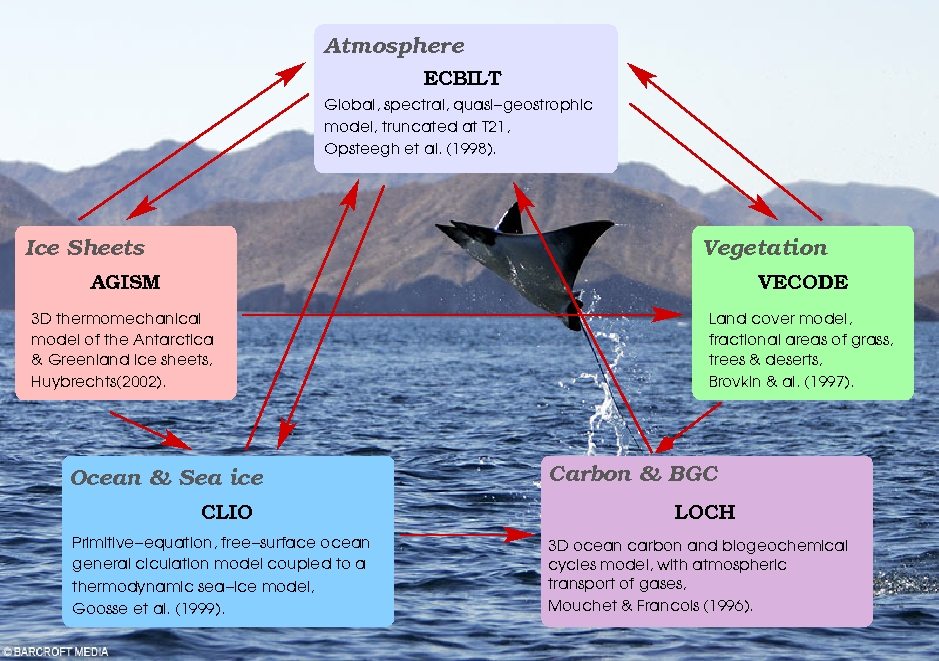The earth system model LOVECLIM
elic | Louvain-la-Neuve
Description
LOVECLIM is an acronym made from the names of the five different models that have been coupled to built the Earth system model: LOch–Vecode-Ecbilt-CLio-agIsm Model (LOVECLIM).
A list of papers using the model could be found here
- Atmosphere: The atmospheric component is ECBILT (version 2) (Opsteegh et al., 1998)a global, spectral, quasi-geostrophic model, truncated at T21, with simple parameterisations for the diabatic heating due to radiative fluxes, the release of latent heat, and the exchange of sensible heat with the surface.
- Ocean–sea ice: The CLIO model (Goosse and Fichefet, 1999) is made up of a primitive-equation, free-surface ocean general circulation model coupled to a thermodynamic–dynamic sea-ice model.
- Vegetation: The terrestrial vegetation module developed by Brovkin et al. (1997) has been included in the coupled ECBILT-CLIO model. Based on annual mean values of several climatic variables, the VECODE model computes the evolution of the vegetation cover described as a fractional distribution of desert, tree, and grass in each land grid cell.
- Ice sheets: ECBILT-CLIO-VECODE has been coupled to Huybrechts (2002)'s model, named AGISM (Antarctica and Greenland Ice-Sheet Model). It is a three dimensional thermomechanical model which simulates the ice flow, the bedrock evolution and the mass balance at the ice-sheet surface.
- Carbon cycle: The terrestrial carbon cycle is simulated by VECODE. LOCH is a three-dimensional model of the oceanic carbon cycle developed by Mouchet et al. (1997).
Contacts at UCL-ELIC
Hugues Goosse, Thierry Fichefet
References
- Goosse H., V. Brovkin, T. Fichefet, R. Haarsma, J. Jongma, P. Huybrechts, A.Mouchet, F. Selten, P.-Y. Barriat, J.-M. Campin, E. Deleersnijder, E. Driesschaert, H. Goelzer, I. Janssens, M.-F. Loutre, M. A. Morales Maqueda, T. Opsteegh, P.-P. Mathieu, G. Munhoven, E. Petterson, H. Renssen, D. M. Roche, M. Schaeffer, C. Severijns, B. Tartinville, A. Timmermann and N. Weber, 2010. Description of the Earth system model of intermediate complexity LOVECLIM version 1.2. Geoscientific Model Development 3, 603–633, http://www.geosci-model-dev.net/3/603/2010/gmd-3-603-2010.html .
- Driesschaert E., T. Fichefet, H. Goosse, P. Huybrechts, I. Janssens, A. Mouchet, G. Munhoven, V. Brovkin and N. Weber, 2007. Modeling the influence of Greenland ice sheet melting on the Atlantic meridional overturning circulation during the next millennia. Geophysical Research Letters 34, L10707, doi:10.1029/2007GL029516
- Brovkin, V., A. Ganapolski, and Y. Svirezhev, 1997. A continuous climate-vegetation classification for use in climate-biosphere studies, Ecol. Modell., 101, 251–261.
- Goosse H. and T. Fichefet, 1999. Importance of ice-ocean interactions for the global ocean circulation: a model study. Journal of Geophysical Research, 104(C10), 23337-23355.
- Huybrechts, P., 2002. Sea-level changes at the LGM from ice-dynamic reconstructions of the Greenland and Antarctic ice sheets during the glacial cycles. Quaternary Science Review, 21, 203-231.
- Mouchet, A. and François, L.M., 1997. Sensitivity of a global oceanic carbon cycle model to the circulation and to the fate of organic matter: preliminary results. Phys. Chem. Earth, 21(5-6) , 511-516.
- Opsteegh, J.D., R.J. Haarsma, F.M. Selten, and A. Kattenberg, 1998. ECBILT: A dynamic alternative to mixed boundary conditions in ocean models. Tellus, 50A, 348–367.
- Selten, F.M., R.J. Haarsma, and J.D. Opsteegh. 1999. On the mechanism of North Atlantic decadal variability. J. Clim., 12, 1956–1973.
